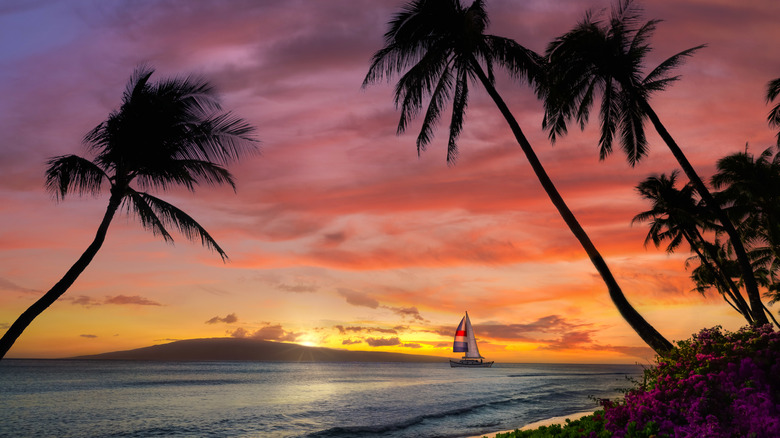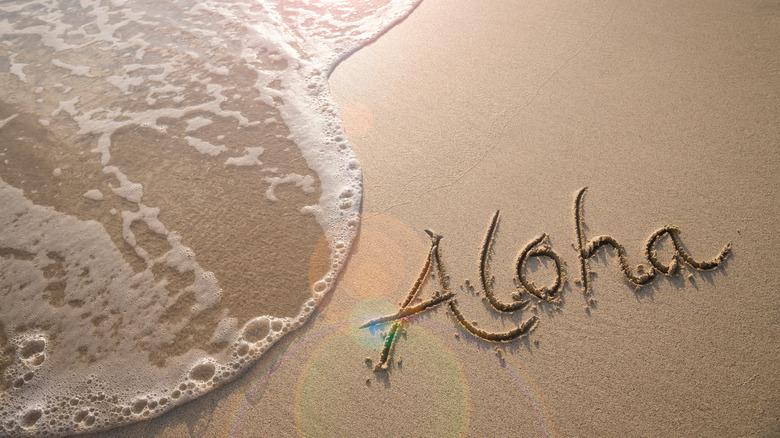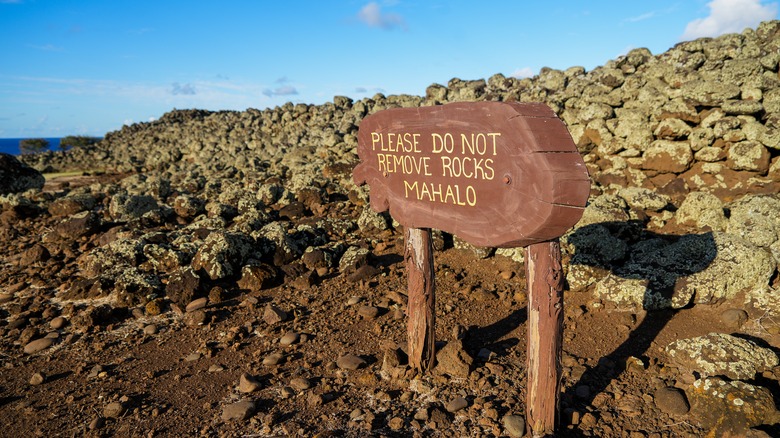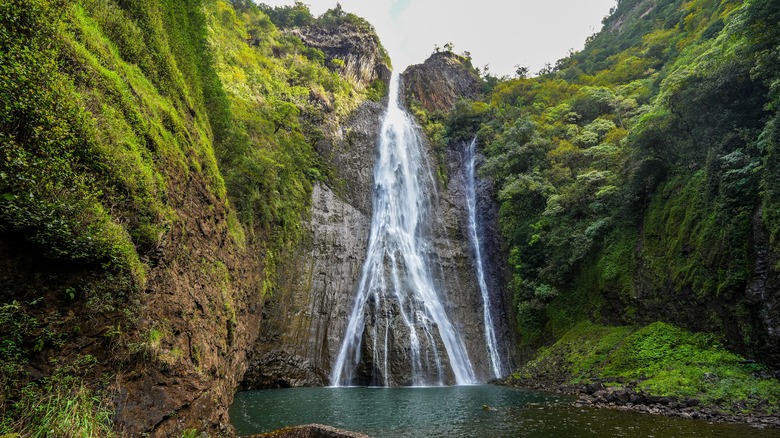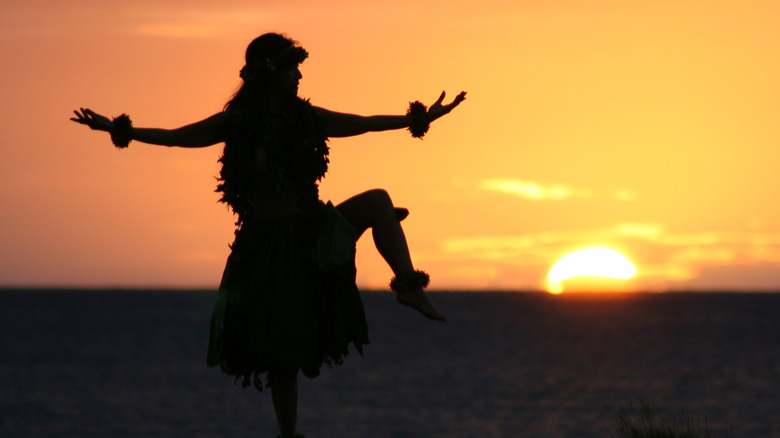How To Be A Respectful Tourist In Hawaii
In pre-pandemic 2019, Hawaii welcomed nearly 10.5 million visitors. Given Hawaii's tropical weather, exquisite nature, idyllic beaches (with legendary surf breaks), and rich cultural heritage, it's easy to understand the appeal of the Pacific island chain. Hawaii tourism is gradually increasing to pre-pandemic levels, and droves of visitors are ready to button back up their floral shirts.
Hawaii is celebrated for its natural beauty and storied heritage, but it's also became a tropical playground for bad behavior. Some tourists to the state have drawn ire for patronizing native Hawaiian culture and disregarding the islands' fragile natural ecology. Unfortunately, the very things that make Hawaii so special are frequently assaulted by disrespectful and irresponsible tourism.
In Hawaiian culture, the term "Aloha" is more than a greeting. Its literal meaning is "the presence of breath," and the spirit of Aloha involves showing kindness towards another, demonstrating humility and patience, and living harmoniously within your environment. If you're planning to visit the Aloha State, there are a few ways to remain a respectful tourist and preserve Hawaii's namesake.
Research Hawaiian etiquette before arriving
Researching cultural etiquette is a good idea whenever visiting anywhere new, but traditional Hawaiian culture is particularly engrained into day-to-day life. Again, one of the major draws for visiting Hawaii is experiencing Hawaiian culture, so avoiding any faux pas can enhance your overall trip.
For example, the presentation of a lei is not a ceremony concocted by the tourism board. The lei has been around since the earliest Polynesian settlers,and the ceremonial garlands were initially given among chiefs as a peace offering between groups. Today, the lei is given for celebration, to symbolize friendship, or to welcome someone, which is why visitors to Hawaii are typically given a lei upon arrival. It's proper etiquette to accept the lei and wear it appropriately around your neck while in the presence of the giver. The only instance not to accept a lei is if you're pregnant (sometimes the closed lei wrapped around a neck can connote unwelcome associations with umbilical cords).
While visitors may be aware that the lei is a popular item in Hawaiian culture, they may not understand its deeper significance. To be a respectful tourist in Hawaii, it's very helpful to know "the why" of ceremony. By doing so, you'll know "the how" of behaving respectfully, allowing for a more immersive, rewarding cultural experience.
Be respectful of modern cultural norms
To dispel the notion that Hawaii is a tropical playground for tourists, we should first acknowledge the nearly 1.5 million residents who call the Hawaiian Islands home. The Hawaiian's rich cultural heritage is integrating into modern life, or you could say the spirit of Aloha is incorporated into daily norms.
While you may feel compelled to rush and fill your tourism itinerary, you'll find the pace slower on the islands. For instance, aggressive driving isn't the norm in Hawaii, and it's common courtesy to always show deference to older individuals, or the kapuna (elders). This could mean giving up your seat to someone older or waiting to hold the door open. Also, if you're invited into someone's home, you should always take your shoes off before entering.
To appreciate Hawaii, we should appreciate its slower pace and the politeness that helps keep that pace. Although being courteous and polite wherever you go is a good idea, you'll find that Aloha is a real, concrete concept in Hawaii, which commonly presents itself through daily interactions. To embrace Aloha is to embrace kindness and politeness.
Treat sacred sites as sacred sites
Representing important cultural meanings or historical events, sacred sites are an important part of Hawaiian culture. These sites include temples, rock carvings, fishponds, stones, and other archeological sites created by ancient Hawaiians. To teach visitors about traditional Hawaiian culture, many of these sites are open to visitors, such as the Pu'uloa Petroglyphs in Hawaii Volcanoes National Park and the statues at Pu'uhonua O Honaunau National Historical Park.
While open to the public, these places are still sacred in Hawaiian culture, and there are a few simple ways to remain respectful when visiting them. Regardless of the type of sacred place, it's generally a good idea to speak quietly (or remain silent) and to stay on designated walking paths. It's also important to leave everything as you found it. Rocks, flowers, and other natural items hold intrinsic value in Hawaiian culture, so rearranging anything can be deemed disrespectful.
Although many sites in Hawaii are open to visitors, some sacred places are either closed or partially closed to public. If you see a "kapu" sign, this translates to "forbidden" and refers to sacred law. Overall, if you visit a sacred site, it's always a good idea to speak to a caregiver. You'll learn both proper protocols and interesting facts about the cultural and historical significance of these cherished sites.
Be aware of Hawaii's fragile biodiversity
A reverence for the land and ocean is a cornerstone of Hawaiian culture. Hawaii's unparalleled natural beauty is a major appeal for tourists, but its natural ecosystem is also incredibly fragile. To be a respectful tourist in Hawaii, it's incredibly important to be aware and respectful of this fragility. This means refraining from littering, only hiking on designated paths, using reef-safe sunscreens, and wearing environmentally friendly bug spray.
Hawaii's far-flung location in the middle of the Pacific Ocean has helped it maintain its delicate natural balance for generations. However, when tourists introduce new biological agents, it can have a devastating effect on native ecology. For instance, the seeds and natural oils introduced by unwashed hiking gear have led to deadly fungal infections among native trees in Hawaii. It's also considered hazardous to geo-tag places in Hawaii on social media, as this causes an unsustainable crush of visitors. When visiting Hawaii, the smaller your footprint is, the more attuned you'll be to your natural surroundings.
In Hawaiian culture, all nature is sacred and contains "mana," or life force. While you may be tempted to take a flower, lava rock, or sand home with you as a souvenir, this is considered taboo in Hawaiian culture. To respect both the culture and fragile biodiversity of Hawaii, simply leave everything as you found it.
Remember that cultural practices are shared, not shown
Cultural practitioners have long been important Hawaiian liaisons to visitors, helping tourist to understand and appreciate traditional Hawaiian culture. Unfortunately, some of these practices have been distorted or exploited over the years. For example, when someone envisions a Hawaiian vacation, they may immediately think of grass-skirted Hula dancers.
However, it's not inherently wrong to think of Hula when thinking of Hawaii. The ancient dance form is one of the most important Hawaiian traditions, considered a sacred art form that tells the ancestral story of Hawaii. In other words, Hula is intended to share the Hawaiian story to visitors. But it's not merely a show.
Before choosing a hotel or other venue that offers Hula, you may want to research to see what cultural advisement the establishment receives. By doing so, you're not only acting as a respectful tourist; you're also refusing to support any exploitative practices.
Individual actions can help shape a more responsible tourism industry, and by being respectful of Hawaiian traditions, the land, and local residents, we became closer to understanding the spirit of Aloha — the most important souvenir to take home.
